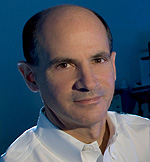The “Rocky” RNA: Stanford researchers trigger muscle stem cells to divide
The “Rocky” RNA: Stanford researchers trigger muscle stem cells to divide
Think of it as the “Rocky” RNA. Researchers here at the School of Medicine have found that a small piece of RNA, called a microRNA, plays a key role in determining when muscle stem cells in mice start to divide. It’s the first time a microRNA has been implicated in the maintenance of the adult stem cell resting state.

Thomas Rando
According to our news story:
“Although on the surface the quiescent state seems to be relatively static, it’s quite actively maintained,” said Thomas Rando, MD, PhD, professor of neurology and neurological sciences. “We’ve found that changing the levels of just one specific microRNA in resting muscle stem cells, however, causes them to spring into action.”
The findings are potentially important because:
Unlike stem cells in the blood or skin, muscle stem cells spend most of their lives nestled in the surrounding tissue. “They don’t do much most of the time,” said Rando. “They remain in a quiescent state for most of a person’s life. When you injure your muscle, however, they begin dividing to repair the damage.” Like all adult stem cells, each muscle stem cell becomes two daughter cells: one with stem cell properties, and the other that continues dividing to become mature muscle cells and fibers to replenish those that are damaged. Without such “asymmetric” division, the stem cells would quickly be depleted after injury.
Pinpointing exactly what calls the stem cells to begin dividing is an important first step to using them in human therapies. It’s also a key to understanding how muscles age and why they become less able over time to repair normal wear and tear.
Rando and his collaborators have published their findings in Nature.
By John Stafford
Stanford University Medical Center
###
* Stanford University Medical Center integrates research, medical education and patient care at its three institutions – Stanford University School of Medicine, Stanford Hospital & Clinics and Lucile Packard Children’s Hospital.
** The above story is adapted from materials provided by Stanford University School of Medicine
________________________________________________________________



















